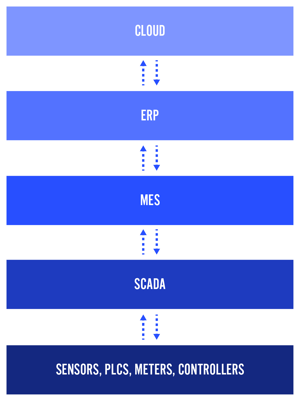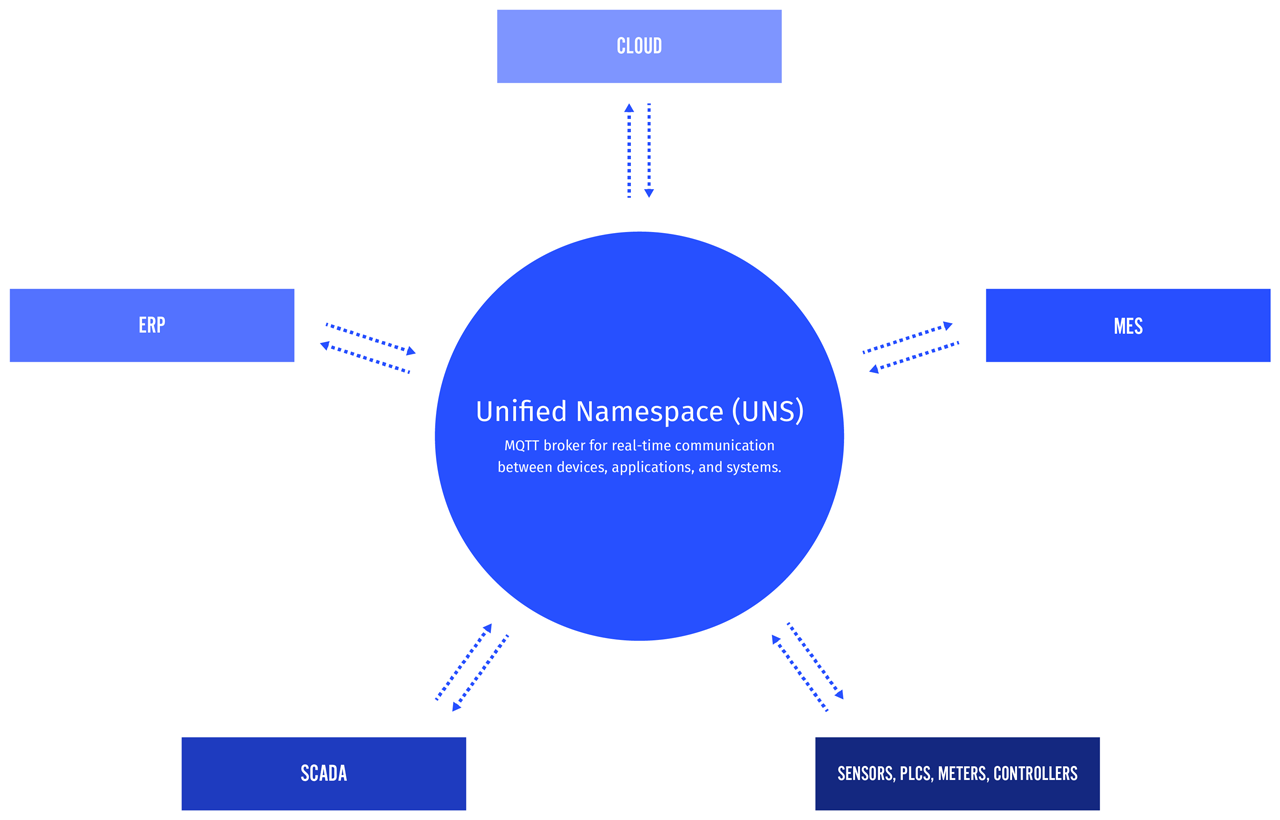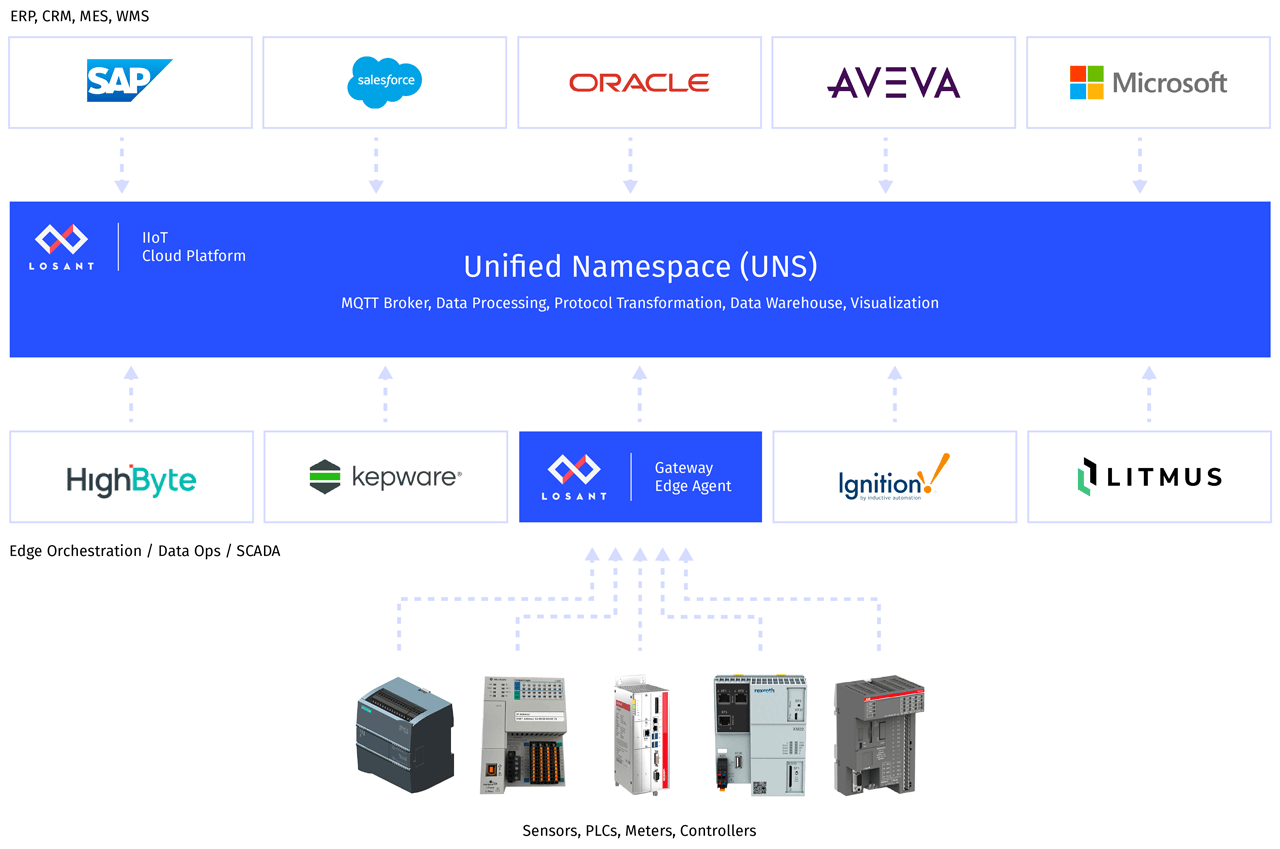A Unified Namespace (UNS) creates a centralized, non-hierarchical structure for accessible, standardized, and real-time data exchange across an organization's IT and OT systems. It mainly applies to the manufacturing sector, enabling seamless integration and real-time data exchange across all IT and OT systems to drive efficiency and innovation. The rising popularity of the UNS is attributed to its ability to break down data silos, offering a streamlined, real-time communication framework that enhances interoperability and efficiency across diverse systems and platforms, making it a cornerstone for industries looking to harness the full potential of digital transformation.
Let’s first look at the model the UNS is replacing, known as the Purdue Model, and then jump into the UNS.
Current Architecture using the Purdue Model
The Purdue Model for industrial control systems organizes manufacturing operations into a hierarchical structure, separating OT from IT across various layers, from the factory floor to enterprise management.
 This framework has been foundational in guiding network security and system integration within manufacturing. However, its rigid, layer-based approach can impede the flow of real-time data and integration across diverse systems and devices, a critical need in the age of digital manufacturing and IoT technologies. The model's structure, while beneficial for security and clarity, often results in data silos and requires complex, bespoke integrations to facilitate communication across layers, hindering scalability and agility in rapidly evolving production environments.
This framework has been foundational in guiding network security and system integration within manufacturing. However, its rigid, layer-based approach can impede the flow of real-time data and integration across diverse systems and devices, a critical need in the age of digital manufacturing and IoT technologies. The model's structure, while beneficial for security and clarity, often results in data silos and requires complex, bespoke integrations to facilitate communication across layers, hindering scalability and agility in rapidly evolving production environments.
As manufacturing becomes increasingly digitized, the limitations of the Purdue Model become more apparent, particularly its difficulty in adapting to the seamless data exchange demands of modern manufacturing technologies. The reliance on point-to-point connections for system integration complicates maintenance and risks data inconsistency, presenting significant challenges to leveraging real-time analytics and achieving digital transformation goals.
The Unified Namespace (UNS)
The UNS represents an innovative architecture that centralizes and standardizes data across an organization's IT and OT systems, eliminating silos and facilitating real-time data exchange. By providing a single, accessible data environment, the UNS enables seamless communication between devices, applications, and systems, regardless of location or the underlying technology. This architecture simplifies data management and ensures that all parts of the organization have immediate access to the data they need.

The main components of a UNS are a data broker or middleware, typically an MQTT broker, and a component to perform data operations close to the edge.
MQTT Broker
Thanks to its lightweight, efficient, and scalable properties, MQTT is typically used as the data broker or middleware in a UNS. By leveraging a publish/subscribe model, MQTT significantly reduces the bandwidth needed for communication, enabling real-time data exchange across various devices and systems, even those with constrained resources. The MQTT broker is the central hub in the UNS, where various components—such as edge devices, MES, SCADA systems, and ERP systems —can publish their data. These systems also subscribe to the data they need, receiving real-time updates. This central role of the MQTT broker facilitates a seamless, efficient flow of information across an organization, ensuring that critical data is accessible where and when needed, supporting operational responsiveness and decision-making agility.
Data Operations at the Edge
Software at the edge to perform data operations is crucial in facilitating connections to equipment via diverse protocols, transforming raw data into its final format, and publishing the data using a standardized MQTT topic framework, such as the widely adopted ISA-95 standard or customized schemas tailored to specific organizational needs. This ensures data is efficiently organized and accessible, leveraging the UNS's flexibility to meet unique operational requirements. Additionally, the software's capability to implement reporting by exception for devices lacking this feature inherently enhances system efficiency and responsiveness, streamlining data processing and ensuring only changes in state or values updating beyond threshold requirements publish data, optimizing the entire system's performance.
Implementing a UNS with Losant
Losant provides all of the components required for a UNS in a single platform, making it the perfect solution when implementing a UNS in your own organization.

Losant provides a managed and scalable MQTT broker, ensuring efficient, real-time data exchange across your organization's devices and systems. Losant’s Gateway Edge Agent handles data ops at the edge by enabling edge workflow to be built in the cloud and deployed to edge devices, enabling…
- Connectivity to equipment using a variety of protocols, including Modbus, Allen-Bradley, Siemens S7, and OPC UA, among others, accommodating a broad spectrum of industrial applications.
- The transformation of raw data into the required formats for actionable insights and decision-making.
- The publication of this processed data over custom MQTT topics tailored to the operational needs of your enterprise.
Losant also provides many more tools to drive more value from your data, such as cloud workflows for event generation and integrations, a time-series database, drag-and-drop dashboards, and the ability to build end-user applications for use cases such as OEE and downtime tracking.
Losant is the perfect platform to implement a UNS, addressing critical operational challenges with innovative and scalable infrastructure and solutions. To learn more about how Losant can help deliver a UNS for your organization, please contact us to schedule a demo.
